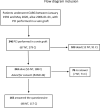Quality of Life After Percutaneous Coronary Intervention in No-Touch Saphenous Vein Grafts is Significantly Better Than in Conventional Vein Grafts
- PMID: 35976202
- PMCID: PMC9423813
- DOI: 10.21470/1678-9741-2021-0576
Quality of Life After Percutaneous Coronary Intervention in No-Touch Saphenous Vein Grafts is Significantly Better Than in Conventional Vein Grafts
Abstract
Objective: To compare health-related quality of life (HRQoL) of patients primarily treated with a no-touch saphenous vein graft with that of patients who received a conventional graft.
Methods: The study included all individuals treated with a percutaneous coronary intervention (PCI) on a saphenous vein graft (SVG) between January 2006 and June 2020. The RAND-36 health survey was used to assess HRQoL. The Mann-Whitney U test was used to test differences in HRQoL between the two groups. Effect size was estimated via Cohen's d. The average treatment effect between the groups was tested by propensity score matching (PSM).
Results: Of the 346 patients treated with a PCI in a stenosed or occluded SVG, 165 responded to RAND-36 (no-touch: n=48; conventional: n=117). Patients with a no-touch graft reported better mean values on seven of the eight health survey domains. Statistically significant differences were observed for four of the domains, all in favour of the no-touch group. The effect size estimates indicated a small difference for five domains, with the highest values (>0.40) seen for the general health and energy/fatigue domains. PSM confirmed a statistically significant difference for the physical functioning and general health domains.
Conclusion: At a mean follow-up of 5.4 years, patients who received a PCI in no-touch vein grafts showed significantly better HRQoL than those who received a PCI in conventional vein grafts.
Keywords: Coronary Artery Bypass; Fatigue; Percutaneous Coronary Intervention; Propensity Score.; Quality of Life; Saphenous Vein.
Conflict of interest statement
Figures
Similar articles
-
Long-term results of percutaneous coronary intervention in no-touch vein grafts are significantly better than in conventional vein grafts.Perfusion. 2025 Jan;40(1):211-220. doi: 10.1177/02676591241230012. Epub 2024 Jan 22. Perfusion. 2025. PMID: 38253348 Free PMC article.
-
Clinical Outcomes After Surgical Revascularization Using No-Touch Versus Conventional Saphenous Vein Grafts: Mid-Term Follow-Up of Propensity Score Matched Cohorts.Semin Thorac Cardiovasc Surg. 2023 Summer;35(2):228-236. doi: 10.1053/j.semtcvs.2021.12.002. Epub 2021 Dec 5. Semin Thorac Cardiovasc Surg. 2023. PMID: 34879223
-
Antiplatelet drug selection in PCI to vein grafts in patients with acute coronary syndrome and adverse clinical outcomes: Insights from the British Cardiovascular Intervention Society database.Catheter Cardiovasc Interv. 2018 Oct 1;92(4):659-665. doi: 10.1002/ccd.27493. Epub 2018 Jan 22. Catheter Cardiovasc Interv. 2018. PMID: 29356278
-
Saphenous Vein Graft Failure: From Pathophysiology to Prevention and Treatment Strategies.Circulation. 2021 Aug 31;144(9):728-745. doi: 10.1161/CIRCULATIONAHA.120.052163. Epub 2021 Aug 30. Circulation. 2021. PMID: 34460327 Review.
-
Drug eluting versus bare metal stents for percutaneous coronary intervention of saphenous vein graft lesions: An updated meta-analysis of randomized controlled trials.Cardiovasc Revasc Med. 2018 Oct-Nov;19(7 Pt B):837-844. doi: 10.1016/j.carrev.2018.03.025. Epub 2018 Apr 3. Cardiovasc Revasc Med. 2018. PMID: 29685385
Cited by
-
Long-term results of percutaneous coronary intervention in no-touch vein grafts are significantly better than in conventional vein grafts.Perfusion. 2025 Jan;40(1):211-220. doi: 10.1177/02676591241230012. Epub 2024 Jan 22. Perfusion. 2025. PMID: 38253348 Free PMC article.
-
For patients with prior coronary artery bypass grafting and recurrent myocardial ischemia, percutaneous coronary intervention on bypass graft or native coronary artery?-A 5-year follow-up cohort study.Clin Cardiol. 2023 Jun;46(6):680-688. doi: 10.1002/clc.24021. Epub 2023 Apr 28. Clin Cardiol. 2023. PMID: 37114396 Free PMC article.
-
Investigating the peri-saphenous vein graft fat attenuation index on computed tomography angiography: relationship with progression of venous coronary artery bypass graft disease and temporal trends.BMC Cardiovasc Disord. 2024 Oct 26;24(1):597. doi: 10.1186/s12872-024-04257-4. BMC Cardiovasc Disord. 2024. PMID: 39462356 Free PMC article.
-
Graft patency of no-touch versus conventionally harvested saphenous vein conduits in coronary artery bypass grafting: A frequentist and Bayesian meta-analysis of randomized trials.JTCVS Open. 2025 Feb 21;24:185-205. doi: 10.1016/j.xjon.2025.02.007. eCollection 2025 Apr. JTCVS Open. 2025. PMID: 40309673 Free PMC article.
References
MeSH terms
LinkOut - more resources
Full Text Sources
Miscellaneous


